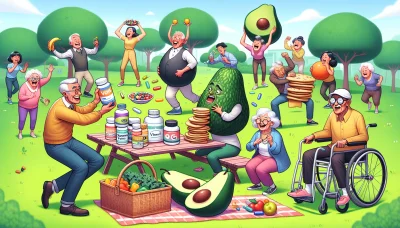Low sugar high fiber foods Quiz
Test Your Knowledge
Question of
Understanding Low Sugar High Fiber Diets
The Basics of Sugar and Fiber
Sugar, especially refined sugar, is a major contributor to various health issues when consumed excessively. It's found in many processed foods and can lead to energy spikes and crashes. On the flip side, fiber is a nutrient powerhouse that aids digestion and keeps you feeling full longer. Unlike sugar, fiber does not break down into glucose, making it essential for a balanced diet.
A grasp on the roles of sugar and fiber in your body is crucial. Consuming too much sugar can increase the risk of diabetes and heart disease, while fiber supports heart health and helps maintain regular bowel movements. The key is to find the right balance, ensuring you're fueling your body with what it truly needs.
Identifying Hidden Sugars in Your Diet
Spotting hidden sugars in food labels is like a treasure hunt, except you're better off not finding the treasure! They are often disguised under names like 'sucrose', 'fructose', or anything ending with '-ose'. Be vigilant about reading labels; sugars lurk in unsuspecting places like salad dressings, breads, and even so-called "health" foods.
To cut down on hidden sugars, prioritize whole foods over processed ones. Cooking at home allows you to control what goes into your meals and avoid those sneaky added sugars that food manufacturers love to include. Remember, awareness is the first step towards making healthier dietary choices!
The Importance of Fiber for Digestive Health
Fiber is the unsung hero of digestive health, promoting regularity and helping to prevent constipation. It acts like a sponge as it travels through your digestive system, absorbing water and expanding to help move waste along. Incorporating a variety of fiber sources like fruits, vegetables, legumes, and whole grains ensures you get both soluble and insoluble fibers which benefit your gut in different ways.
Beyond just aiding digestion, fiber also plays a role in maintaining a healthy gut microbiome. It serves as a prebiotic, meaning it feeds the good bacteria in your gut which are essential for overall health. A diet rich in high-fiber foods can be transformative for your digestive wellbeing.
Benefits of a Low Sugar High Fiber Diet
Embarking on a low sugar high fiber diet has numerous benefits that extend beyond just weight management. This type of diet stabilizes blood sugar levels, reducing risks associated with diabetes and metabolic syndrome. It's also linked to lower cholesterol levels and reduced risk of certain types of cancer.
- Managing Blood Sugar Levels: A low sugar intake prevents sudden spikes in blood glucose, helping to manage or prevent diabetes. Fiber slows down carbohydrate digestion and absorption which contributes to more stable blood sugar throughout the day.
- Enhancing Weight Loss Efforts: High fiber foods are typically less energy-dense yet more filling. They help control hunger pangs and can reduce overall calorie intake without leaving you feeling deprived or hungry.
Essential Foods for a Low Sugar High Fiber Diet
Top Vegetables to Include
Integrating vegetables into your diet is crucial for maintaining low sugar and high fiber intake. They are powerhouse foods that not only provide essential nutrients but also help in regulating blood sugar levels. Vegetables should be the cornerstone of every meal to ensure you're getting the fiber your body needs without the added sugars.
When shopping for vegetables, opt for fresh produce whenever possible. Frozen vegetables are a good alternative, as they retain most of their nutritional value. Aim for variety and color on your plate to cover a broad spectrum of vitamins and minerals.
Leafy Greens and Their Nutritional Value
Leafy greens like spinach, kale, and Swiss chard are superfoods with incredibly low sugar content and abundant fiber. These greens are also rich in vitamins A, C, E, and K, along with minerals like iron and calcium. Incorporating them into your diet can support heart health and aid in digestion.
One effective way to include leafy greens is by adding them to smoothies or salads. This not only enhances flavor but also increases your daily nutrient intake without piling on extra sugar.
Cruciferous Vegetables for Balanced Meals
Cruciferous vegetables such as broccoli, cauliflower, Brussels sprouts, and cabbage are another excellent choice for those following a low sugar high fiber diet. They contain phytonutrients that may help lower inflammation and reduce the risk of developing cancer.
Their high fiber content is essential for healthy digestion and can keep you feeling full longer. Including these vegetables in your meals contributes to a balanced diet while keeping your sugar intake minimal.
Best Fruits for Natural Sweetness
Fruits are nature's treat packed with vitamins, antioxidants, and fibers. However, some fruits have high sugar content which might not align with a low-sugar diet goal. Choosing fruits with natural sweetness that have lower sugar content can satisfy sweet cravings without compromising dietary restrictions.
Berries: A Low Sugar Option
Berries such as strawberries, blueberries, raspberries, and blackberries are among the best fruit options for a low-sugar diet due to their high fiber content and lower glycemic index. They pack a nutritional punch with antioxidants that fight free radicals.
- Eat berries fresh or frozen to preserve their nutritional integrity.
- Incorporate them into your breakfast cereal or yogurt for an added flavor burst without extra sugar.
- Berries work great as healthy snacks throughout the day or in smoothies for a refreshing treat.
- Avoid berry-flavored products that may contain added sugars - always check the label!
Apples and Pears for Sustained Energy
Apples and pears are fantastic choices when it comes to fruits that provide sustained energy release due to their high fiber content. They also contain important vitamins like vitamin C and potassium which support overall health.
Eating these fruits whole rather than juiced or pureed provides the most benefit since it includes their natural fibers which help regulate blood sugar levels. These fruits' versatility makes them easy to incorporate into any meal or snack time.
Planning Your Low Sugar High Fiber Meals
Breakfast Ideas to Start Your Day Right
Kick off your morning with a burst of energy! High fiber breakfasts are not just nutritious; they're your ticket to a fulfilled day without the sugar crash. Think whole grains, oats, and bran that keep you satisfied and your digestive system happy.
Protein is your ally, creating breakfasts that are both low in sugar and high in satisfaction. Eggs, Greek yogurt, and cottage cheese are fantastic options that pair beautifully with fresh fruits and nuts. They help stabilize blood sugar levels, ensuring you start your day fully charged!
High Fiber Cereals and Grains
Dive into the world of high fiber cereals and grains! Opt for unsweetened oatmeal or muesli that provides an excellent fiber foundation. Add a sprinkle of chia seeds or flaxseeds for an extra fiber kick. These grains will keep you full until lunch!
Don't forget about quinoa! This versatile grain can be a delicious warm breakfast porridge. Mix in some almonds and berries for a delightful morning treat that's both nutritious and satisfying.
Protein-Packed Breakfasts with Minimal Sugar
Say goodbye to sugary breakfasts and hello to protein-packed starts! Prepare omelets or scrambled eggs loaded with vegetables like spinach, mushrooms, and peppers. These ingredients are low in sugar but rich in nutrients.
For those on-the-go mornings, consider a homemade smoothie with whey protein, unsweetened almond milk, and a handful of greens. It's a quick, portable option that doesn't compromise on nutrition or taste.
Dinner Recipes for Sustained Fullness
Dinner is more than just a meal; it's a chance to nourish your body for the hours ahead! Focus on recipes that integrate legumes and beans. They not only offer fiber but also provide plant-based protein to keep you going strong.
Create plates filled with whole foods for an all-around balanced meal. Combine lean proteins like chicken or fish with quinoa or brown rice and a rainbow of vegetables. This approach ensures you get the right mix of nutrients without overloading on sugar.
Incorporating Legumes and Beans
- *Enumerative Lists: Used for itemizing elements, events, or tasks, often in a specific order. Ordered Lists: Sequence matters (e.g., procedural steps, rankings). Unordered Lists: Sequence does not matter (e.g., grocery lists, to-do lists). *Descriptive Lists: Each item is accompanied by additional details or a description. Useful for catalogs, menus, or directories. *Checklists: Designed for tracking completion or presence of items or tasks. Common in project management, inspections, and daily routines. *Multilevel Lists: Nested lists with items having sub-items. Useful for outlining complex information, hierarchical data, or detailed plans. *Matrix Lists: Information presented in a two-dimensional grid or table format, where lists are organized both vertically and horizontally. *Priority Lists: Items are organized based on their importance or urgency. Common in project management and personal productivity systems. *Comparative Lists: Used for juxtaposing two or more items, options, or ideas, often to highlight differences or similarities.
Creating Balanced Plates with Whole Foods
Aim for harmony on your plate by combining various food groups. Start with leafy greens as your base; add colorful veggies like bell peppers or carrots; then choose high-fiber starches such as sweet potatoes or squash.
Balancing these components isn't just about nutrition it's about flavors too! Season your dishes with herbs like rosemary or thyme instead of heavy sauces to keep things light yet deliciously satisfying.
Snacking on a Low Sugar High Fiber Diet
Healthy Snack Options
Embarking on a low sugar high fiber diet doesn't mean you have to give up snacking! In fact, the right snacks can keep you energized and help you stick to your dietary goals. Opting for snacks that are high in fiber and low in sugar aids in maintaining steady blood sugar levels and keeps hunger pangs at bay.
When choosing snacks, focus on whole foods that are minimally processed. This ensures that you're getting the full nutritional benefits without added sugars. For instance, fresh fruits, raw veggies, and whole grains are excellent sources of natural fiber and are incredibly snack-friendly.
Nuts and Seeds for Satiety
Nuts and seeds are powerhouses of nutrition, packed with fiber that helps you feel full longer. Almonds, chia seeds, and flaxseeds can be easily incorporated into your diet. Just a handful of these can provide a satisfying crunch and keep those cravings at bay.
Remember though to watch your portions as nuts and seeds are also high in calories. Moderation is key! A small container or pre-measured baggies can help manage serving sizes without compromising on the convenience of this perfect grab-and-go snack option.
Veggie Sticks and Hummus for Crunch
Veggies like carrots, bell peppers, and cucumbers cut into sticks make for a fantastic crunchy snack that's both low in sugar and high in fiber. Pair them with a savory dip like hummus for added flavor and a protein boost. This combination not only satisfies your snack cravings but also contributes to your daily vegetable intake.
Preparing these snacks ahead of time ensures that you always have healthy options on hand. Store your veggie sticks in water-filled containers in the fridge to keep them fresh and crisp throughout the week!
Sweet Treat Alternatives
Craving something sweet doesn't have to derail your healthy eating plan. There are numerous delicious alternatives that satisfy your sweet tooth while aligning with a low sugar high fiber diet. Embrace natural sweetness from fruits or opt for homemade treats where you control the ingredients.
Making smart substitutions can make all the difference. Use ripe bananas or applesauce to sweeten recipes naturally instead of relying on added sugars. These fruit-based solutions provide sweetness along with beneficial nutrients and fiber.
Fruit-Based Desserts
Fruits are nature's candy and make excellent dessert substitutes. Think grilled peaches, berry salads, or baked apples sprinkled with cinnamon. These desserts offer the sweetness you desire plus fiber, vitamins, and antioxidantswithout the sugar crash associated with traditional sweets.
Berries especially are low-glycemic fruits which means they have less impact on blood sugar levels while providing a burst of flavor. Combine them with Greek yogurt for an indulgent yet healthy dessert option or midday snack.
DIY Low Sugar High Fiber Snack Bars
- Select Whole Grain Bases: Oats or quinoa flakes make a great foundation for homemade snack bars.
- Add Nuts and Seeds: Incorporate almonds, walnuts, chia, or flaxseeds for texture and nutrients.
- Bind with Natural Sweeteners: Use mashed bananas, pureed dates, or applesauce to hold your bars together without added sugars.
- Spice it Up: Cinnamon, nutmeg, or vanilla extract can add flavor depth without extra calories.
- Bake or Chill: Depending on your recipe, either bake at a low temperature to preserve nutrients or chill in the fridge until set.
- Portion Control: Cut bars into servings immediately after preparation to avoid overindulging later on.
- Variety is Key: Experiment with different combinations of fruits and nuts to keep things interesting!
- Avoid Processed Add-ins: Skip the chocolate chips or sugary dried fruits; opt for cacao nibs or goji berries instead.
- Packaging Matters: Wrap individual bars for convenienceperfect for on-the-go snacking!
Crafting your own snack bars gives you complete control over what goes into themensuring they're tailored to fit your dietary needs while still being absolutely delicious! Plus, making them at home can be a fun activity that even gets kids involved in healthy eating habits early on!
The key takeaway? Snacking smartly is entirely possible on a low sugar high fiber dietwith just a bit of planning and creativity! So go ahead and indulge in these guilt-free pleasures that fuel your body right!
Understanding Carbohydrates in Your Diet
The Role of Carbs in Energy Production
Carbohydrates are the body's primary source of energy, particularly for brain function and physical activity. They break down into glucose, fuelling your cells and keeping you powered throughout the day. Without adequate carbs, your body may feel sluggish and unable to perform at its peak.
Not all carbs are created equal, though. The quality of carbohydrates consumed is crucial for sustained energy levels. Incorporating a balanced mix of carbs into your diet ensures that your energy production is both efficient and consistent.
Complex vs. Simple Carbohydrates
Complex carbohydrates, found in foods like whole grains and legumes, are made up of long chains of sugar molecules. These take longer to digest, resulting in a slower and more stable release of energy. On the other hand, simple carbohydrates consist of short chains of sugars that provide quick but fleeting boosts of energy.
Understanding the difference between these two types helps in managing blood sugar levels and maintaining a healthy diet. Opting for complex carbs over simple ones can lead to better health outcomes and prolonged satiety, keeping those hunger pangs at bay.
Glycemic Index and Its Significance
The Glycemic Index (GI) is a system that ranks food based on how quickly they raise blood sugar levels after eating. Foods with a high GI spike your blood sugar rapidly, while those with a low GI result in a gradual rise. Paying attention to the GI can aid in controlling glucose fluctuations and managing conditions like diabetes.
Foods with low to moderate GI values are an integral part of a balanced diet. They help in weight management and reduce risks associated with heart disease and type 2 diabetes. Monitoring the GI of foods can be especially beneficial for athletes looking to optimize their performance through nutrition.
- Choose whole fruits over juices: Whole fruits have fiber that slows down sugar absorption.
- Select grains wisely: Opt for whole grains like quinoa or barley instead of refined products.
- Be cautious with 'low-fat' options: They often contain added sugars to improve taste.
- Moderation is key: Even healthy carbs can contribute to weight gain when overconsumed.
Smart Carb Choices for Low Sugar Diets
A low-sugar diet doesn't mean eliminating all carbohydrates; it means choosing them smartly. Selecting carbs that are low in added sugars yet high in fiber can support overall health without spiking blood glucose levels. It's about finding the right balance that works for your body's needs.
Incorporating smart carb choices into meals can enhance satiety, improve metabolic health, and even contribute to better mental clarity throughout the day. By focusing on nutrient-dense sources, you're not only reducing sugar intake but also boosting your intake of vitamins, minerals, and antioxidants.
Whole Grains for Long-Lasting Energy
Whole grains are an excellent choice for maintaining steady energy levels due to their high fiber content which slows digestion and provides a prolonged energy release. Not only do they help you feel full longer, but they also have numerous health benefits including reducing the risk of chronic diseases such as heart disease and type 2 diabetes.
Foods like brown rice, oats, and whole grain breads should be staples in any healthy diet. They supply essential nutrients like B vitamins which are critical for energy metabolism within the body.
Starchy Vegetables and Their Benefits
Starchy vegetables like sweet potatoes, squash, and corn are packed with vitamins, minerals, fiber, and antioxidants. They offer an array of health benefits while providing sustainable energy due to their complex carbohydrate content.
The inclusion of starchy vegetables in your diet can contribute to overall nutritional balance by offering an alternative source of carbohydrates that supports blood sugar control. When prepared healthilybaked or steamed rather than friedthey can be a delicious part of a nutritious meal plan.
Managing Cravings and Staying on Track
Coping with Sugar Cravings
Sugar cravings can derail even the most diligent health enthusiasts. Understanding that these urges are often a response to stress, hormonal fluctuations, or even habit is key to overcoming them. By identifying the triggers, one can develop strategies to manage and eventually conquer the sweet temptation.
Hydration is a secret weapon against cravings. Sometimes, what we perceive as a craving for sugar is actually dehydration in disguise. Drinking a glass of water before giving in to a treat often diminishes the craving. Additionally, ensuring you're getting enough sleep plays a crucial role in regulating hunger hormones, which in turn can help reduce sugar cravings.
Natural Sweeteners as Alternatives
Natural sweeteners offer the sweetness you crave without the negative health impacts of refined sugars. Options like stevia, honey, and pure maple syrup can satisfy your sweet tooth with fewer calories and a lower glycemic impact. Transitioning to these alternatives can be an effective stepping stone towards reducing overall sugar consumption.
Incorporating fruits into your diet is another excellent way to combat sugar cravings. Fruits not only provide natural sweetness but also come packed with fiber and essential nutrients. Berries, apples, and pears can be particularly satisfying due to their high fiber content, which helps slow down sugar absorption and increases satiety.
Mindful Eating Strategies
Mindful eating is about being present during meals and snacks, appreciating your food, and listening to your body's hunger cues. By eating slowly and without distraction, you give your body time to register fullness, which can prevent overindulgence in sugary foods.
Combining foods wisely also aids in managing cravings. Pairing a small amount of dark chocolate with nuts or having whole grain toast with peanut butter provides satiety through healthy fats and proteins while allowing for a touch of indulgence. This balance keeps cravings at bay and prevents feelings of deprivation.
Long-Term Success Tips
Achieving long-term dietary success involves more than just willpower; it requires strategy. Structuring your environment to support your goals is paramount. Keep tempting sweets out of sight or better yet, out of the house entirely. Stock up on healthy snacks so when cravings hit, you have better options at hand.
Meal planning is another cornerstone of dietary triumphs. Preparing meals ahead of time ensures you always have access to nutritious choices that align with your goals. This proactive approach reduces the likelihood of impulsive eating decisions that usually favor less healthy options.
Building a Supportive Dietary Environment
- Surround yourself with like-minded individuals who support your dietary goals.
- Create a kitchen that encourages healthy eating by displaying fruits and vegetables while tucking away processed snacks.
- Choose restaurants wisely when dining out; look for those that offer wholesome options that cater to your dietary preferences.
- Communicate your goals with friends and family so they understand how best to support you in social settings.
Tracking Progress and Adjusting as Needed
Maintaining motivation is easier when you track progress. Whether it's jotting down what you eat or using an app to monitor intake, seeing tangible evidence of your commitment reinforces positive behavior changes. Celebrate small victories along the way as they build up to significant achievements over time.
Flexibility is vital for long-term adherence; rigid diets are often unsustainable. If you find certain aspects of your diet are too challenging or causing unnecessary stress, reevaluate and adjust accordingly. The goal is a balanced lifestyle that promotes health without compromising enjoyment or mental well-being.
Addressing Common Challenges and Solutions
Eating Out and Social Events
Stepping into a restaurant doesn't mean abandoning your nutrition goals. It's all about making informed choices, such as opting for grilled over fried foods or asking for dressings on the side. Scan the menu ahead of time if possible, and don't be shy to request modifications that align with your dietary needs.
Social events can be a minefield for healthy eating, but with strategies in place, you can navigate them like a pro. Focus on filling your plate with vegetables and lean proteins, and pace yourself by sipping water between bites. This way, you'll enjoy the event without overindulging.
Making Smart Choices at Restaurants
When dining out, prioritize dishes packed with vegetables and lean proteins. Start with a salad or broth-based soup to help control hunger. Avoid dishes labeled as "crispy" or "creamy," which are often higher in calories. Instead, look for keywords like "steamed," "baked," or "grilled."
Don't forget that portion sizes in restaurants are often larger than necessary. Consider sharing an entree with a friend or packing half to take home before you start eating. This approach allows you to enjoy your favorite meals while keeping portions in check.
Navigating Social Gatherings with Confidence
At social gatherings, position yourself away from the snack table to minimize mindless munching. Engage in conversations and activities that don't revolve around food. When it's time to eat, use a small plate; it encourages smaller portions and helps you eat less.
- Bring a Dish: Contribute a healthy option to the spread; this ensures there's something you can enjoy guilt-free.
- Mindful Drinking: Limit alcohol intake as it can lower inhibitions and lead to overeating.
- Savor Each Bite: Eat slowly and appreciate the flavors, which leads to better satiety cues recognition.
- Avoid Going Hungry: Eat a light, nutrient-rich snack beforehand to avoid overindulging at the event.
Overcoming Plateaus and Setbacks
Hitting a plateau can be frustrating, but it's a common part of any weight loss journey. To push past it, consider shaking up your routine by increasing physical activity or tweaking your calorie intake slightly. Keep track of your habits to identify areas that may need adjustment.
Setbacks can be disheartening but view them as learning opportunities rather than failures. Reflect on what led to the setback and develop strategies for similar situations in the future. Remember that progress is not always linear and every step forward counts.
Reassessing Dietary Choices for Continued Success
If you're facing a plateau, reassess your dietary choices by logging your food intake meticulously for a week or two. This action might reveal hidden calories that are sneaking in through condiments or snacks. Adjusting portion sizes could also reignite your progress without making drastic changes.
Staying Motivated Through Challenges
Maintaining motivation is crucial when faced with challenges. Set small attainable goals alongside your main objectives to provide frequent feelings of accomplishment. Celebrate these milestones in healthy ways such as buying new workout gear instead of indulging in treats.












